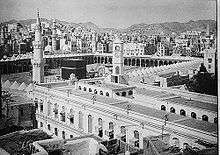Battle of Mecca (1916)
| Battle of Mecca | |||||||
|---|---|---|---|---|---|---|---|
| Part of Arab Revolt of the Middle Eastern theatre of World War I | |||||||
 Mecca in 1910 | |||||||
| |||||||
| Belligerents | |||||||
|
|
| ||||||
| Commanders and leaders | |||||||
|
|
| ||||||
| Strength | |||||||
| ~5,000-10,000 | 1,000[1] | ||||||
The Battle of Mecca occurred in the Muslim holy city of Mecca in June and July 1916. On June 10, the Sharif of Mecca, Hussein bin Ali, the leader of the Banu Hashim clan started a revolt against the Ottoman Caliphate from this city. The Battle of Mecca was part of the Arab Revolt of World War I.
Background
The Sharif of Mecca was planning to make an Arab state from Aden to Aleppo. For this purpose he sought the help of the British. He prepared his four sons too for this ambitious adventure.
Events
In early June 1916 most of the Ottoman army had gone to Taif, a hill station in Arabia accompanying Ghalib Pasha, the governor of Hijaz. Only 1,000 men were left to defend Mecca. Many of them were asleep in barracks in the valley on June 10 when the Sharif of Mecca, Hussein bin Ali fired a shot into the air from the window of the Hashemite palace signaling the beginning of the Arab Revolt. Hearing this his 5000 supporters started firing on Turkish troops in three fortresses overlooking the holy city, and at the Jirwall barracks on Jeddah road. The attack upon the Turkish forces was sudden and their acting commanding officer was unaware that a revolt had started. As Sharif's and the Ottoman banners were of same colour, the Turkish commander could not see the difference. He telephoned Sharif Hussain about the situation and he was told the reason and he (the Turkish commander) was told to surrender. He refused. The battle started and continued. The next day Binu Hashim's forces advanced and captured Bash-Karakol at Safa corner adjacent to the Masjid al-Haram. On the third day, Hamidia, the Ottoman Government Office, was captured, as well as the Deputy Governor. Now the captive Deputy Governor ordered his remaining Turkish troops to surrender. They refused.
A situation of stalemate developed. Sir Reginald Wingate sent two artillery pieces from Sudan via Jeddah with trained Egyptian gunners. They breached the walls of the Turkish fort. The Sharifain army attacked and the fate of these defenders was sealed. On July 4, 1916 the last Turkish resistance in Mecca, Jirwal barracks, capitulated, after three weeks of stubborn resistance.
Results
It was the beginning of the end of the Ottoman Empire and it was the beginning of a Hashemite kingdom whose capital was Mecca. Gradually it expanded northward. This battle left deep scars on the Middle East. Arab states came under strong European influence. The Ottoman caliphate ended and Palestine came under British rule, leading to the eventual existence of the state of Israel. The Sharif of Mecca was himself deposed by the rival Ibn Saud and his dream of an Arabian state stretching from Yemen to Syria remained unrealized.
See also
References
- History of the Arab Revolt (on King Hussein's website)
- Arab Revolt at PBS
- Fromkin, David (2010). A Peace to End All Peace: The Fall of the Ottoman Empire and the Creation of the Modern Middle East. Macmillan. ISBN 978-0-8050-8809-0.
- Lawrence, T. E. (1935). Seven Pillars of Wisdom. Doubleday, Doran, and Co.
- ↑ Spencer C. Tucker, Arab Revolt (1916-1918), The Encyclopedia of World War I, ABC-CLIO, 2005, ISBN 1-85109-420-2, page 117.